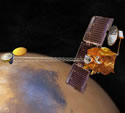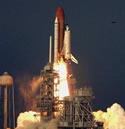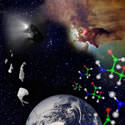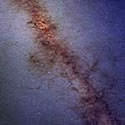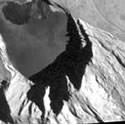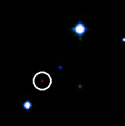
Image credit: NASA
A team of astronomers from the Space believe that red quasars may be more common in the Universe than previously thought. Quasars are bright, distant objects and the current theory is that they are caused by the black holes that reside at the centre of galaxies – because they’re so hot, they usually appear blue. Red quasars are largely obscured by dust and were typically hard to find in visible light, but they can be found in infrared light. The team compared sky surveys in visible and infrared light and turned up 17 of the elusive red quasars.
Elusive red quasars may be more common than previously expected, according to a recent survey conducted by a research team headed by Dr. Mark Lacy, an astronomer at the Space Infrared Telescope Facility Science Center in Pasadena.
The team will display its report on June 3 at the American Astronomical Society meeting in Albuquerque, N.M.
“Every galaxy is thought to have contained a quasar at some point in its lifetime. We wanted a good estimate of the number of quasars existing early in the life of the universe to compare to the numbers of black holes we see in the centers of galaxies today,” Lacy said.
Quasars are thought to be caused by black holes that reside at the centers of galaxies and attract matter from their host galaxies. As the matter falls into the black hole, it heats up and glows brightly, producing a quasar. Because the gas is so hot, many quasars appear very blue in color. Red quasars, however, have smoke-like dust in front of them. This dust absorbs the blue light from the quasar, making it appear redder and fainter than it would otherwise.
Red quasars, which are less common than normal quasars, are difficult to detect because their colors make them hard to distinguish from stars. To find red quasars, Lacy and his team first matched two surveys revealing the positions of existing quasars, among other objects. The two surveys used were the near-infrared Two Micron All-Sky Survey, carried out by the University of Massachusetts and processed at the JPL/Caltech Infrared Processing and Analysis Center in Pasadena, and the Faint Images of the Radio Sky at Twenty-centimeters survey, conducted by R.H. Becker, R.L. White, and D.J. Helfand using the Very Large Array, about 50 miles west of Socorro, New Mexico.
To determine which of the existing quasars were red, the team then used digitized Palomar Observatory sky survey plates, which show images of the sky in visible light. Red quasars were faint or invisible in these plates because of the dust in front of them, but were detected in the infrared. Halfway through their project, Lacy and his team had already found 17 of the reddest quasars known.
“Seventeen is a big number because it implies that there are a lot more red quasars in the universe that we have yet to find,” Lacy said.
Lacy’s team suspects there are many quasars that are even redder than those they observed. They believe these objects, called Quasar-2’s, are just as common as normal quasars. These highly reddened quasars were undetectable through their methods; however, other surveys have reported that they exist.
Lacy co-authored the report with M. Gregg and R.H. Becker, University of California, Davis and the Institute of Geophysics and Planetary Physics Lawrence Livermore National Laboratory, Livermore, Calif.; R.L. White, the Space Telescope Science Institute, Baltimore, Md.; and E. Glikman and D.J. Helfand, Columbia University, New York, N.Y.
The Faint Images of the Radio Sky at Twenty-centimeters survey is supported by the National Science Foundation, Arlington, Va.; the Institute for Geophysics and Planetary Physics Lawrence Livermore National Laboratory; the California Space Institute of the University of California; the Space Telescope Science Institute; Columbia University; Sun Microsystems, Santa Clara, Calif.; the North Atlantic Treaty Organization, Brussels, Belgium; and the National Geographic Society, Washington, D.C.
The Space Infrared Telescope Facility Science Center will handle science operations for the Space Infrared Telescope Facility mission, launching next year. The mission is managed by NASA’s Jet Propulsion Laboratory, Pasadena, Calif., for NASA’s Office of Space Science, Washington, D.C.
Original Source: NASA/JPL News Release

